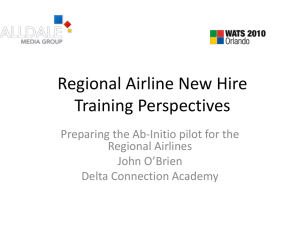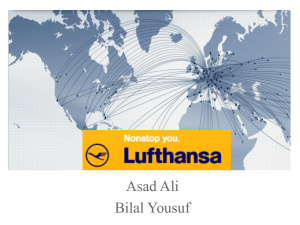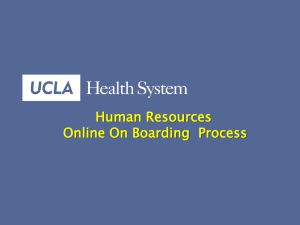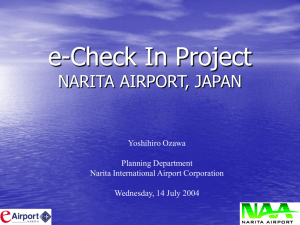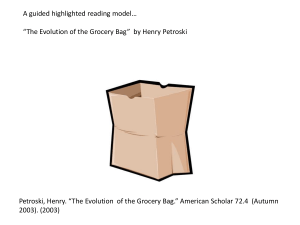PCN-Analysis-Exercis.. - Sampson on Services
advertisement
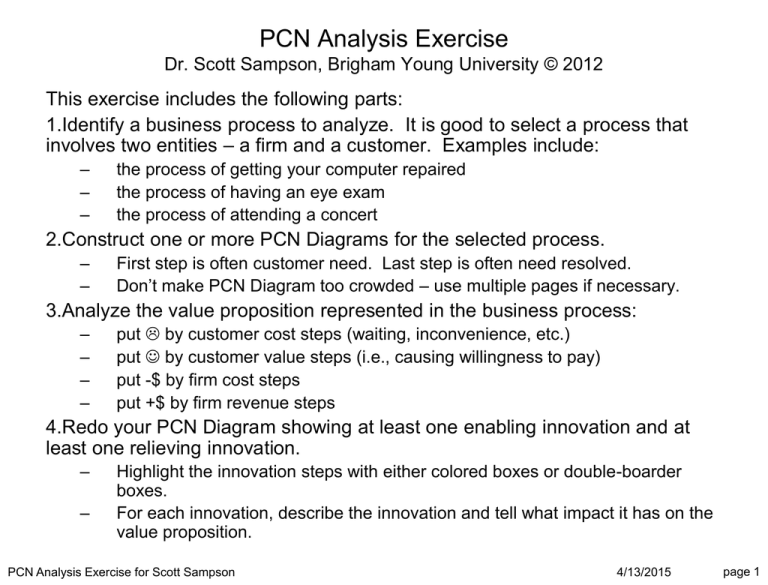
PCN Analysis Exercise Dr. Scott Sampson, Brigham Young University © 2012 This exercise includes the following parts: 1.Identify a business process to analyze. It is good to select a process that involves two entities – a firm and a customer. Examples include: – – – the process of getting your computer repaired the process of having an eye exam the process of attending a concert 2.Construct one or more PCN Diagrams for the selected process. – – First step is often customer need. Last step is often need resolved. Don’t make PCN Diagram too crowded – use multiple pages if necessary. 3.Analyze the value proposition represented in the business process: – – – – put by customer cost steps (waiting, inconvenience, etc.) put by customer value steps (i.e., causing willingness to pay) put -$ by firm cost steps put +$ by firm revenue steps 4.Redo your PCN Diagram showing at least one enabling innovation and at least one relieving innovation. – – Highlight the innovation steps with either colored boxes or double-boarder boxes. For each innovation, describe the innovation and tell what impact it has on the value proposition. PCN Analysis Exercise for Scott Sampson 4/13/2015 page 1 PCN Analysis Exercise – Optional Parts This parts of this exercise may be optional (see instructor): 5.On a copy of your PCN Diagram, include notations showing important sensory elements (signs, symbols, ambient conditions, etc.) that guide customers in their roles of the process. For each sensory element indicate what impact it is intended to have on customer behavior. 6.On a copy of your PCN Diagram, indicate a few service failure points (F) and show some steps that would be used to effectively respond to the failure. 7.The best learning comes from participants sharing their work with the group. You can do the exercise on paper, or electronically. One way to do it electronically is to edit the pages of this file. If you choose to do the PCN Analysis Exercise electronically, please do the following: 1. Put your team member names in the page footer (select “Header & Footer” from the menu, change footer, and click “Apply to All” for all pages). 2. Name your file “PCN-Last-Names-Of-Team-Members.ppt” 3. Email it to the course email address listed in the syllabus. PCN Analysis Exercise for Scott Sampson 4/13/2015 page 2 PCN Analysis Exercise: Airline example Part 1. Business process to analyze • Team members: – Scott Sampson • Process: – In this exercise we will analyze a commercial airline process. – We will consider the process from a passenger booking a flight to actually going on the flight, where the passenger books online. PCN Analysis Exercise for Scott Sampson 4/13/2015 page 3 Part 2. PCN Diagram of process (first page) PCN Diagram for process: Airline passenger booking a ticket on an airline website Provider’s Process Domain Independent processing Surrogate interaction Customer’s Process Domain Direct interaction Direct interaction Surrogate interaction Independent processing visit an airline website need air transportation enter search information no develop flight schedule provide flight options acceptable flight? yes select flight process payment enter payment information send eticket print eticket wait until flight day PCN Analysis Exercise for Scott Sampson 4/13/2015 page 4 Part 2. PCN Diagram of process (second page) PCN Diagram for process: Airline passenger check-in and transportation process Provider’s Process Domain Independent processing Surrogate interaction Customer’s Process Domain Direct interaction Direct interaction Surrogate interaction Independent processing drive to airport check identification find parking check reservation receive checked bags wait in line get to terminal tag checked bags transfer bags to appropriate gate go through security place bags on belt give boarding pass land plane clean and refuel plane load bags on plane fly to destination unload checked bags board plane wait for boarding exit plane walk to bag claim watch and wait transport bags to baggage claim PCN Analysis Exercise for Scott Sampson retrieve bags depart airport 4/13/2015 page 5 Part 3: Assessment of provider revenue (+$) and costs (-$), customer value () and costs () PCN Diagram for process: Airline passenger booking a ticket on an airline website Provider’s Process Domain Independent processing Surrogate interaction Customer’s Process Domain Direct interaction Direct interaction Surrogate interaction Independent processing visit an airline website need air transportation enter search information no develop flight schedule provide flight options acceptable flight? yes select flight +$ process payment enter payment information send eticket print eticket wait until flight day PCN Analysis Exercise for Scott Sampson 4/13/2015 page 6 PCN Diagram for process: Part 3: Assessment of provider revenue (+$) and costs (-$), customer value () and costs () Airline passenger check-in and transportation process Provider’s Process Domain Independent processing Customer’s Process Domain Surrogate interaction Direct interaction Direct interaction Surrogate interaction Independent processing drive to airport check identification check reservation wait in line receive checked bags find parking get to terminal -$ -$ transfer bags to appropriate gate land plane clean and refuel plane load bags on plane -$ -$ -$ tag checked bags place bags on belt go through security board plane transport bags to baggage claim PCN Analysis Exercise for Scott Sampson wait for boarding exit plane fly to destination unload checked bags give boarding pass walk to bag claim watch and wait retrieve bags depart airport 4/13/2015 page 7 PCN Diagram for process: Part 4. Enabling Innovation: Online checking and bag tagging Airline passenger check-in and transportation process Provider’s Process Domain Independent processing Customer’s Process Domain Surrogate interaction Direct interaction Direct interaction Surrogate interaction Independent processing check in on airline website check identification print boarding pass and luggage tag check reservation drive to airport find parking get to terminal receive checked bags -$ tag checked bags -$ clean and refuel plane load bags on plane -$ -$ transport bags to baggage claim PCN Analysis Exercise for Scott Sampson go through security place bags on belt -$ give boarding pass board plane wait for boarding exit plane fly to destination unload checked bags -$ transfer bags to appropriate gate land plane scan luggage tag and tape on bag* walk to bag claim watch and wait retrieve bags depart airport 4/13/2015 page 8 PCN Diagram for process: Part 4. Relieving Innovation: Provided county airport shuttle Airline passenger check-in and transportation process Provider’s Process Domain Independent processing Customer’s Process Domain Surrogate interaction Direct interaction drive passenger to airport Direct interaction Surrogate interaction Independent processing meet shuttle at county parking lot drive to airport check identification -$ (+$?) check reservation wait in line receive checked bags find parking get to terminal -$ -$ transfer bags to appropriate gate land plane clean and refuel plane load bags on plane -$ -$ -$ tag checked bags place bags on belt go through security board plane transport bags to baggage claim PCN Analysis Exercise for Scott Sampson wait for boarding exit plane fly to destination unload checked bags give boarding pass walk to bag claim watch and wait retrieve bags depart airport 4/13/2015 page 9 Part 4. Description of Enabling and Relieving Innovations • • • Enabling Innovation – Passengers print their own boarding pass and luggage tag. Description: – Passengers have the option of printing their own boarding pass and luggage tags at home within 24 hours of their flight. – The only contact customer has with the airline before security is allowing a low-wage employee to tape the luggage tag on the luggage. – If the luggage tag printed by the passenger is unusable, the low-wage employee can scan the tag or boarding pass and print out a new one. Impact on Value Proposition: – Reduced cost to customer, who does not need to wait in line to check bags (low-wage employee is highly efficient) – Reduced -$ cost to firm, replacing multiple bag checkers with one or two low-wage employees. PCN Analysis Exercise for Scott Sampson • • • Relieving Innovation – Provide a county-based shuttle to the airport Description: – When passenger books their ticket, they are given the opportunity to buy a slot on a shuttlebus that departs from a location in the passenger’s county or city. – Passenger still needs to get a ride to the shuttle location, or drive car and pay for parking there. – Shuttles leave at fixed intervals, but passenger would have a reserved seat. – Passenger would print out their shuttle confirmation at time of ticketing. Impact on Value Proposition: – Reduced cost, since customer only has to drive to a county location to take the airline shuttle bus. – Reduced -$ cost and cost, since less expensive than a private shuttle. – Don’t have to deal with airport parking (reduced ). – Additional revenue opportunity +$ for airline. 4/13/2015 page 10 Part 5. Key sensory elements in this process PCN Diagram for process: Airline passenger check-in and transportation process Provider’s Process Domain Independent processing Customer’s Process Domain Surrogate interaction Direct interaction Direct interaction Surrogate interaction drive to airport check identification attire of employee check reservation receive checked bags tag checked bags transfer bags to appropriate gate Independent processing information about which line to be in find parking wait in line get to terminal line layout noise or music info about policies and procedures go through security place bags on belt give boarding pass land plane clean and refuel plane load bags on plane board plane exit plane fly to destination unload checked bags wait for boarding info about where bag claim for this flight is walk to bag claim noise, smells, entertainment, seating, electrical outlets, boarding progress info watch and wait transport bags to baggage claim PCN Analysis Exercise for Scott Sampson retrieve bags depart airport 4/13/2015 page 11 Part 5. Description of sensory elements and impact on customer behavior • step: wait in line – behavior: passenger not spending time in wrong line and line jumping. – element (sign): information about which line to be in. – behavior: passenger having reasonable expectations about line duration. – element (space): line layout that allows passenger to see how line progresses. – behavior: passengers not being grumpy in line. – element (ambient condition): provide pleasant music. • step: check in – behavior: passenger have confidence in employee – element (symbols): attire of employee makes employee look more like a captain than a baggage handler. • step: go through security – behavior: passenger be prepared for that specific process (e.g. belt removed, pockets emptied, shoes off, etc.) – element (sign): provide information in line about that airport’s specific policies and procedures. PCN Analysis Exercise for Scott Sampson • step: wait for boarding – behavior: passengers experience severe psychological costs during the waiting process – element (ambient condition): provide a pleasant noise (other than CNN disaster news), provide a pleasant smell (like candy), provide some type of appropriate entertainment (besides CNN). – element (function): furnish seating areas with more power outlets, so that waiting passengers can self-entertain or be productive. – element (sign): provide passengers with a clear identification of boarding progress (besides PA announcements). • step: walk to bag claim – behavior: passenger going to the wrong bag claim area and reporting missing bags. – element (sign): provide disembarking passengers with information about where baggage claim is for the flight they are just getting off of. 4/13/2015 page 12 Part 6. Indication of two service failure points. PCN Diagram for process: Airline passenger booking a ticket on an airline website Provider’s Process Domain Independent processing Surrogate interaction Customer’s Process Domain Direct interaction Direct interaction Surrogate interaction Independent processing visit an airline website need air transportation enter search information (F1) server goes down develop flight schedule no acceptable flight? provide flight options yes select flight process payment enter payment information send eticket print eticket (F2) passenger never receives e-ticket wait until flight day PCN Analysis Exercise for Scott Sampson 4/13/2015 page 13 Part 6. Steps to effectively recover from failure (F1). PCN Diagram for process: Airline passenger booking a ticket on an airline website Provider’s Process Domain Independent processing Surrogate interaction Customer’s Process Domain Direct interaction Direct interaction Surrogate interaction Independent processing visit an airline website need air transportation enter search information (F1) server goes down develop flight schedule no acceptable flight? provide flight options yes provide form for customer to provide phone number airline calls customer select flight discuss flight alternatives and options process payment provide payment information send eticket print eticket wait until flight day PCN Analysis Exercise for Scott Sampson 4/13/2015 page 14 Part 6. Steps to effectively recover from failure (F2). PCN Diagram for process: Airline passenger booking a ticket on an airline website Provider’s Process Domain Independent processing Surrogate interaction Customer’s Process Domain Direct interaction Direct interaction Surrogate interaction Independent processing visit an airline website need air transportation enter search information no develop flight schedule acceptable flight? provide flight options yes select flight process payment enter payment information send e-ticket link click e-ticket link (F2) passenger never clicks e-ticket link airline calls customer wait until flight day print e-ticket discuss problem and determine if alternate ticketing method is needed PCN Analysis Exercise for Scott Sampson 4/13/2015 page 15 Part 6. Description of plan for service recovery • • • • Failure (F1): Airline web server goes down – This failure may occur because of technical problem, system overload. – We assume that when the reservation system goes down the router is still able to redirect requests to another system or web page. Details: – When server goes down, customer is immediately redirected to a form that explains that there is a problem, and if the customer will provide a phone number then an agent will call the customer back about the flight. – Customer might optionally provide a time window to be called back. – If the server comes back up, agents can call customers and tell them that is the case. – Customer would not be charged any extra fees for using an agent for reservations. Benefits to customer: – Not needing to call airline and wait on hold. Benefits to airline: – Fewer lost customers. • • • • PCN Analysis Exercise for Scott Sampson Failure (F2): e-ticket not received – This failure may happen with airlines that email the e-ticket to passengers. Causes might include: • bad email address • e-ticket filtered as spam • customer does not recognize e-ticket email message • customer does not check email account very often • and so forth Details: – To detect this failure (without waiting for customers to report it), instead of sending the eticket the airline sends a link to the e-ticket. If the customer has not clicked the e-ticket link with 5 days we assume a service failure. – On detected failure, the airline calls the customer at the number they gave when ticketing. – Airline agent asks customer if they are aware of the problem. – Agent records in database any information about cause of the problem (e.g.s above). – Agent determines an alternate email address, or if snail-mail ticketing is necessary (perhaps for a mailing fee). – Airline tracks common causes of problems and makes process adjustments accordingly. Benefits to passenger: – Less likely to forget about not having e-ticket. Benefits to airline: – Able to identify more errors and correct causes. 4/13/2015 page 16
